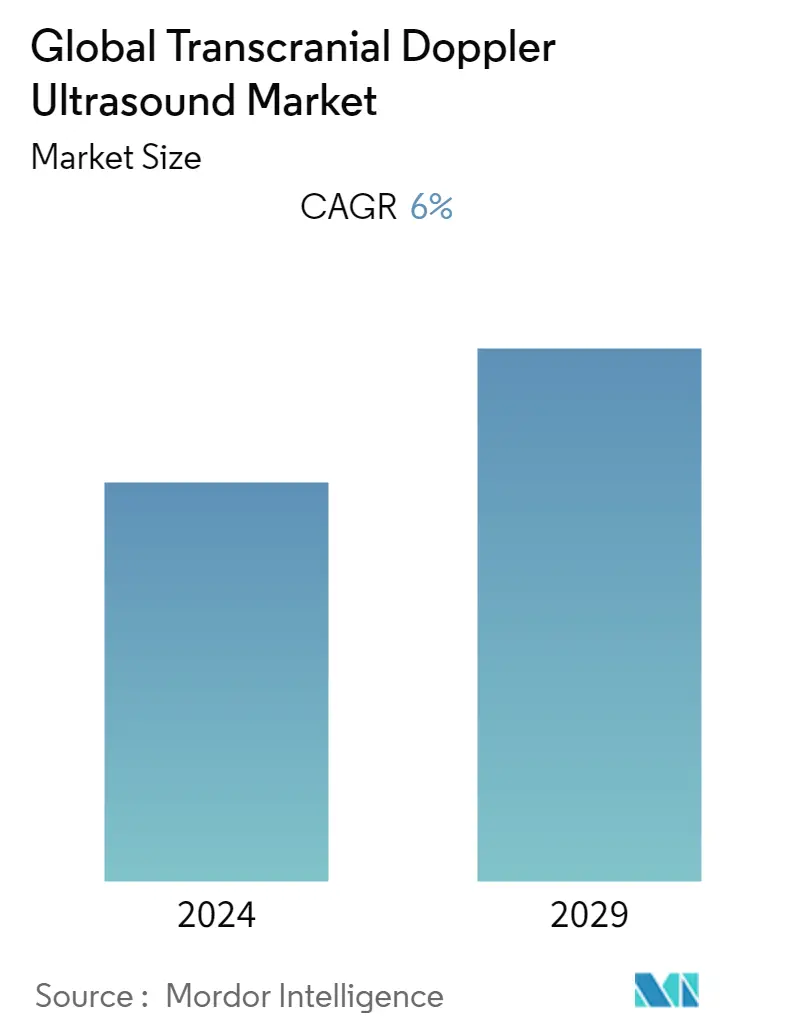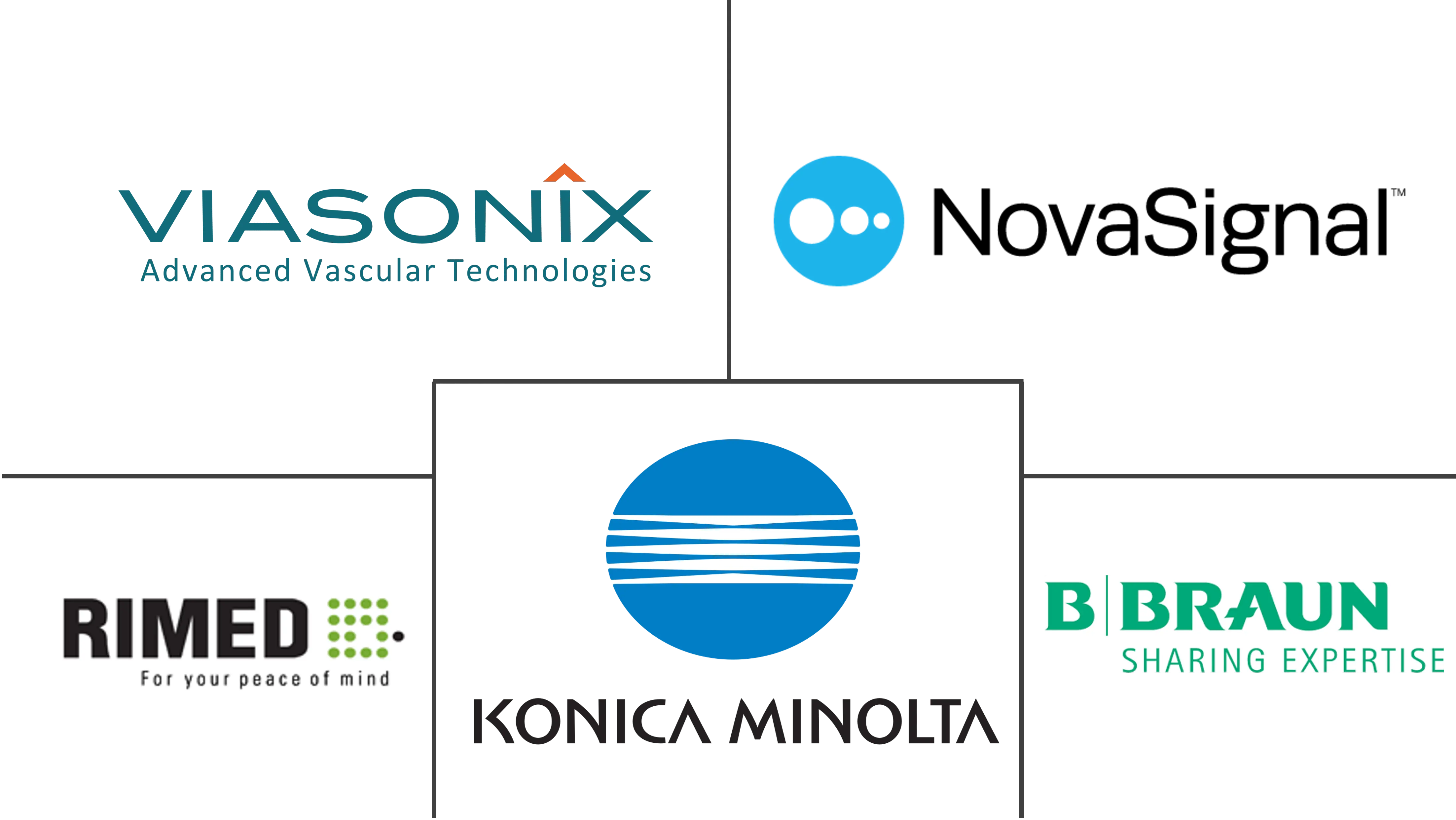Market Size of Global Transcranial Doppler Ultrasound Industry

| Study Period | 2019 - 2029 |
| Base Year For Estimation | 2023 |
| Forecast Data Period | 2024 - 2029 |
| CAGR | 6.00 % |
| Fastest Growing Market | Asia Pacific |
| Largest Market | North America |
Major Players
*Disclaimer: Major Players sorted in no particular order |
Need a report that reflects how COVID-19 has impacted this market and its growth?
Transcranial Doppler Ultrasound Market Analysis
The Transcranial Doppler Ultrasound Market is expected to register a CAGR of 6% during the forecast period.
The COVID-19 pandemic affected healthcare systems globally and resulted in the interruption of usual care in many healthcare facilities, exposing vulnerable patients to significant risks. COVID-19 has impacted the growth of the studied market. For instance, according to an article published in March 2021, titled 'Transcranial Doppler Ultrasound (TCD) Evidence of Active Cerebral Embolization in COVID-19', Clinical TCD ultrasonography for the identification of microemboli was performed on patients with confirmed COVID-19 between May and June 2020, in Chicago. It has been observed that three individuals with confirmed COVID-19 and evidence of cerebral artery microemboli were identified using TCD ultrasonography for microemboli identification, one of whom was receiving therapeutic anticoagulation. Thus, TCD ultrasonography offers a non-invasive way to assess cerebral microemboli in COVID-19 patients and can help assess therapy response in cases with suspected or confirmed disorders of hypercoagulability. Hence, COVID-19 has a significant impact on market growth.
Certain factors that are propelling the market growth are the growing preference for transcranial doppler in detecting various cerebrovascular diseases and the rising technological advancements.
The increasing burden of cerebrovascular disease among the population increase the adoption of transcranial doppler ultrasound devices for continuous neuromonitoring is expected to increase the market growth over the forecast period. For instance, according to an article published in April 2022, titled 'Transcranial Doppler Ultrasonography as a Diagnostic Tool for Cerebrovascular Disorders', the transcranial doppler (TCD) method of diagnosing cerebrovascular diseases is less expensive, non-invasive, and practically easier than the other imaging techniques. In addition, the transcranial doppler method is considered the most practicable method to monitor vascular alterations in response to therapy for treating cerebrovascular problems such as cerebral sinus venous thrombosis (CSVT), acute ischemic stroke (AIS), intracranial atherosclerotic stenosis (ICAS) and cerebral vasospasm (CV). Furthermore, TCD can detect most lesions amenable to interventional treatment, such as stenting and local thrombolysis as well as angioplasty, as well as monitor the impact of the underlined interventions. Thus, the increasing applications of TCD in detecting as well as monitoring various cerebrovascular diseases are expected to increase its adoption, thereby fueling market growth.
Similarly, as per an article published in September 2021, titled 'Transcranial Doppler ultrasonography (uses, limitations, and potentials): a review article', it has been observed that TCD as a non-invasive easily available at the bedside, the radiation-free device can help prevent the neurologic deficits in critically ill patients with ischemic stroke, subarachnoid hemorrhage (SAH), and traumatic brain injury (TBI) who have cerebral hemodynamic disturbances, who require extended neuromonitoring. This is expected to boost the demand for transcranial doppler ultrasound, thereby bolstering market growth.
Furthermore, according to the data published by the Centers for Disease Control and Prevention, in December 2021, titled 'Concussions and Brain Injuries in Children: the United States, 2020', it has been observed that about 6.8 percent of children aged 17 and under had experienced a concussion or brain injury symptoms, in 2020. In addition, as per the same source, the percentage of children who had ever experienced concussion or brain injury symptoms increased with age, rising from 2.0 percent in children aged 5 to 12.2 percent in children aged 12 to 17. Thus, traumatic brain injuries alter cerebrovascular function by causing long-term neurodegeneration, poor autoregulation, subarachnoid hemorrhage, vasospasms, edema, and disruption of the blood-brain barrier, which is expected to increase the demand for extended neuromonitoring, thereby propelling the market growth.
However, the lack of skilled expertise in handling the ultrasound system is expected to restrain the market growth over the forecast period.
